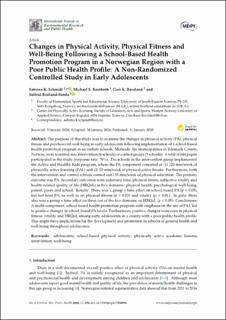| dc.contributor.author | Schmidt, Sabrina Krogh | |
| dc.contributor.author | Reinboth, Michael Sæther | |
| dc.contributor.author | Resaland, Geir Kåre | |
| dc.contributor.author | Bratland-Sanda, Solfrid | |
| dc.date.accessioned | 2020-04-07T07:19:44Z | |
| dc.date.available | 2020-04-07T07:19:44Z | |
| dc.date.created | 2020-02-05T09:21:40Z | |
| dc.date.issued | 2020 | |
| dc.identifier.citation | Schmidt, S. K., Reinboth, M. S., Resaland, G. K., & Bratland-Sanda, S. (2020). Changes in Physical Activity, Physical Fitness and Well-Being Following a School-Based Health Promotion Program in a Norwegian Region with a Poor Public Health Profile: A Non-Randomized Controlled Study in Early Adolescents. International Journal of Environmental Research and Public Health, 17(3), 896. | en_US |
| dc.identifier.issn | 1660-4601 | |
| dc.identifier.uri | https://hdl.handle.net/11250/2650564 | |
| dc.description.abstract | The purpose of this study was to examine the changes in physical activity (PA), physical fitness and psychosocial well-being in early adolescents following implementation of a school-based health promotion program in secondary schools. Methods: Six municipalities in Telemark County, Norway, were recruited into intervention (6 schools) or control groups (9 schools). A total of 644 pupils participated in the study (response rate: 79%). The schools in the intervention group implemented the Active and Healthy Kids program, where the PA component consisted of (1) 120 min/week of physically active learning (PAL) and (2) 25 min/week of physical active breaks. Furthermore, both the intervention and control schools carried out 135 min/week of physical education. The primary outcome was PA. Secondary outcomes were sedentary time, physical fitness, subjective vitality and health-related quality of life (HRQoL) in five domains: physical health, psychological well-being, parent, peers and school. Results: There was a group x time effect on school-based PA (p < 0.05), but not total PA, as well as on physical fitness (p < 0.05) and vitality (p < 0.01). In girls, there also was a group x time effect on three out of the five domains on HRQoL (p < 0.05). Conclusions: A multi-component, school-based health-promotion program with emphasis on the use of PAL led to positive changes in school-based PA levels. Furthermore, positive changes were seen in physical fitness, vitality and HRQoL among early adolescents in a county with a poor public health profile. This might have implications for the development and promotion in schools of general health and well-being throughout adolescence. | en_US |
| dc.language.iso | eng | en_US |
| dc.rights | Navngivelse 4.0 Internasjonal | * |
| dc.rights.uri | http://creativecommons.org/licenses/by/4.0/deed.no | * |
| dc.title | Changes in Physical Activity, Physical Fitness and Well-Being Following a School-Based Health Promotion Program in a Norwegian Region with a Poor Public Health Profile: A Non-Randomized Controlled Study in Early Adolescents | en_US |
| dc.type | Peer reviewed | en_US |
| dc.type | Journal article | en_US |
| dc.description.version | publishedVersion | en_US |
| dc.rights.holder | © 2020 by the authors | en_US |
| dc.source.volume | 17 | en_US |
| dc.source.journal | International Journal of Environmental Research and Public Health | en_US |
| dc.source.issue | 3 | en_US |
| dc.identifier.doi | 10.3390/ijerph17030896 | |
| dc.identifier.cristin | 1790981 | |
| cristin.ispublished | true | |
| cristin.fulltext | original | |
| cristin.qualitycode | 1 | |

